
Here’s how we use Higher Logic Vanilla to manage product feedback from our customer community, and how you can too.
Our Feedback Process Needed More Structure
Before adopting our own ideation features, our approach to handling customer feedback wasn’t exactly structured. Requests often jumped directly to our founders or circulated through customer success, support, and product teams without a clear workflow. Decisions sometimes felt reactive, guided more by who spoke loudest or most recently rather than by strategic priority.
We realized we needed a clearer, more organized method to capture and prioritize customer ideas, so naturally, we turned to Vanilla.
Here’s a look at how we restructured our product feedback process and ended up implementing over 120 customer-submitted ideas, and counting.
How We Capture and Prioritize Customer Ideas
We knew what our customers wanted because, well, we wanted it too. So we built idea-capturing tools directly into our community platform. Here’s what that looks like in practice.
A Central, Easy-to-Find Home for Ideas
The first step was giving ideas a clear home within our Success Community. We put a prominent “Submit a Product Idea” tile directly on our homepage, with easy access through the main menu as well.
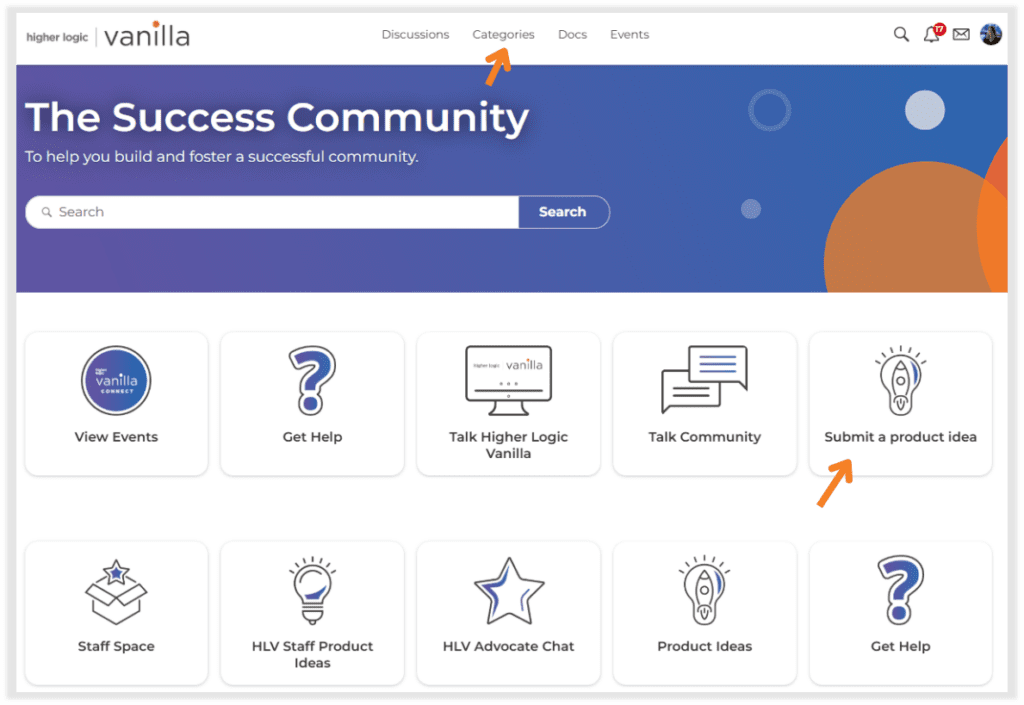
Once you’re there, it’s straightforward to either submit a new idea or explore what others have already suggested.
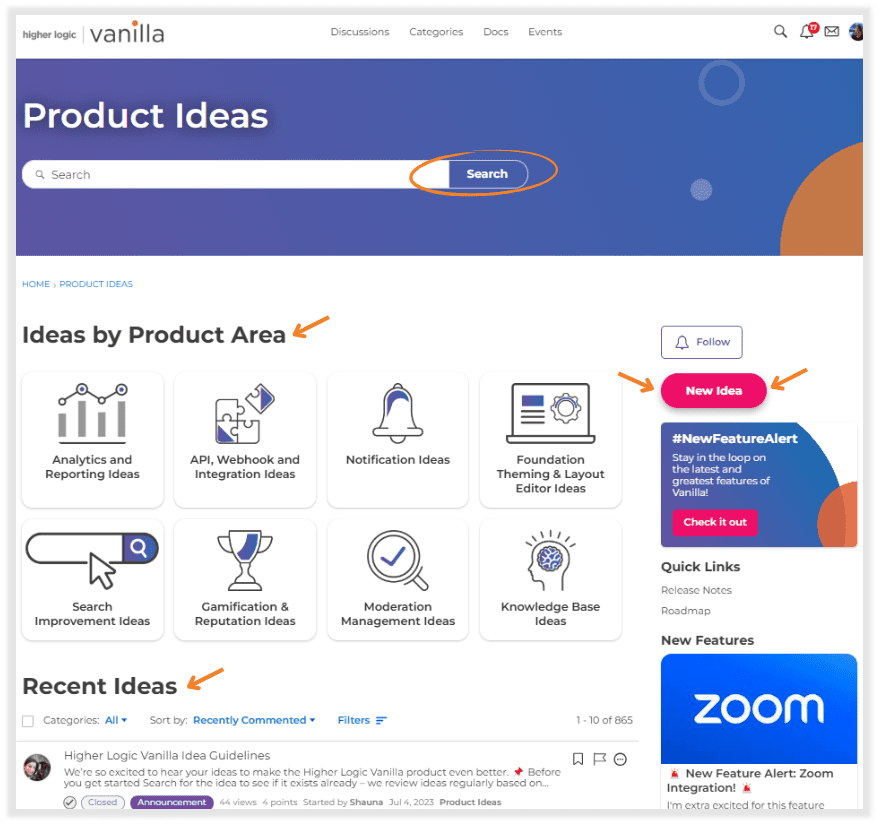
To keep things organized, we grouped ideas into categories by product area, like analytics improvements or moderation tools. There’s also a dedicated search bar, making it simple to find existing ideas and avoid duplicates. Sorting and filtering tools make browsing easy, anyone can quickly find and follow popular or recent ideas.
Encouraging Community Engagement
After an idea gets submitted, the community can immediately engage—voting on ideas they like and commenting to add more context or help clarify what’s most important to them. Vanilla automatically surfaces the most popular and discussed ideas, making it clear at a glance which suggestions users care about most.
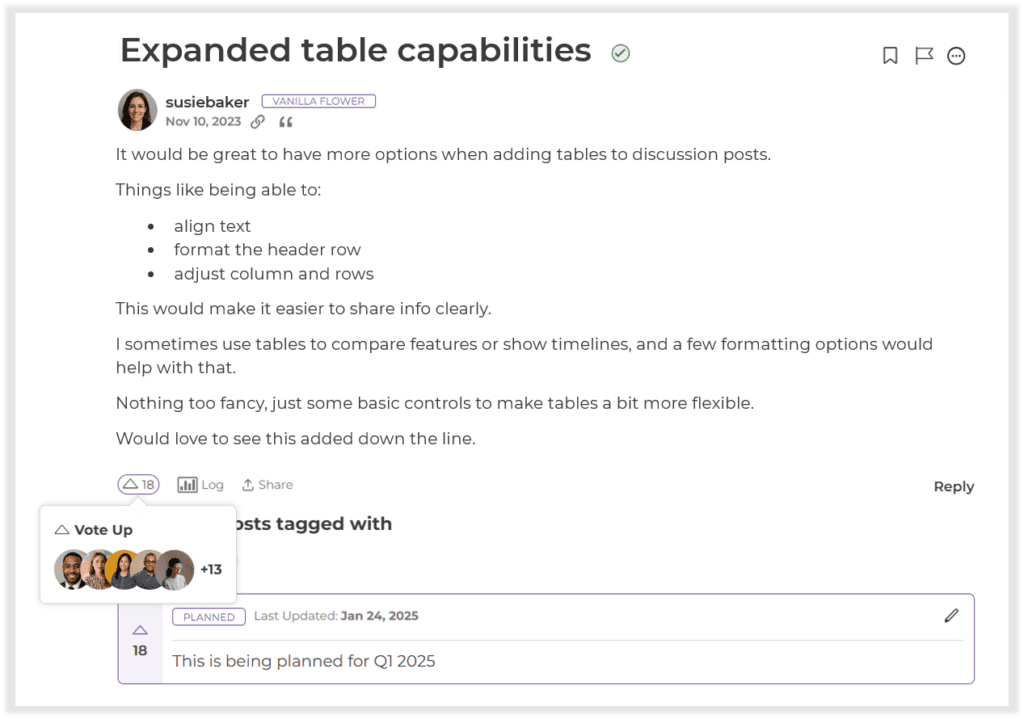
We also lean on Vanilla’s gamification features, awarding points for each upvote an idea gets. It’s a small touch, but it genuinely encourages community participation.
Keeping Everyone Informed
To keep everyone in the loop, we use Vanilla’s custom status labels—like “being considered,” “planned,” “in progress,” or “completed”—so users always know exactly where their ideas stand. These statues display at the bottom of a product idea post, as shown in the image above. Product managers can also add personalized updates directly into the status field, providing additional context or next steps whenever helpful.

To streamline idea management even further, you can configure automated workflows: once an idea reaches a specified number of upvotes, it’s automatically updated to the appropriate status—and you can even trigger an escalation. For example, combine it with notification preferences to email the product manager when an idea gains traction. This helps ensure popular ideas don’t get overlooked.
We also wanted to give users a simple way to track the ideas that matter most to them personally. So we added sections like “My Ideas” and “Ideas I’ve Voted On,” so users can follow along as things develop.
Turning Ideas Into Insights With Built-In Analytics
We use Vanilla’s analytics capabilities to track how ideas are flowing through the system. The out-of-the-box Ideation Dashboard gives us a high-level view of what’s happening—how many new ideas have come in, who’s submitting them, and which ones are getting the most traction through votes, comments, and views. We can filter everything by category or subcommunity to spot trends in different parts of the product.
For more specific needs, we’ve built custom dashboards using Vanilla’s chart editor. It lets us create tailored visualizations, like line graphs or tables, that highlight the data points we care most about. Once the charts are built, we can drag and drop to customize the layout, making it easy to present or share internally.
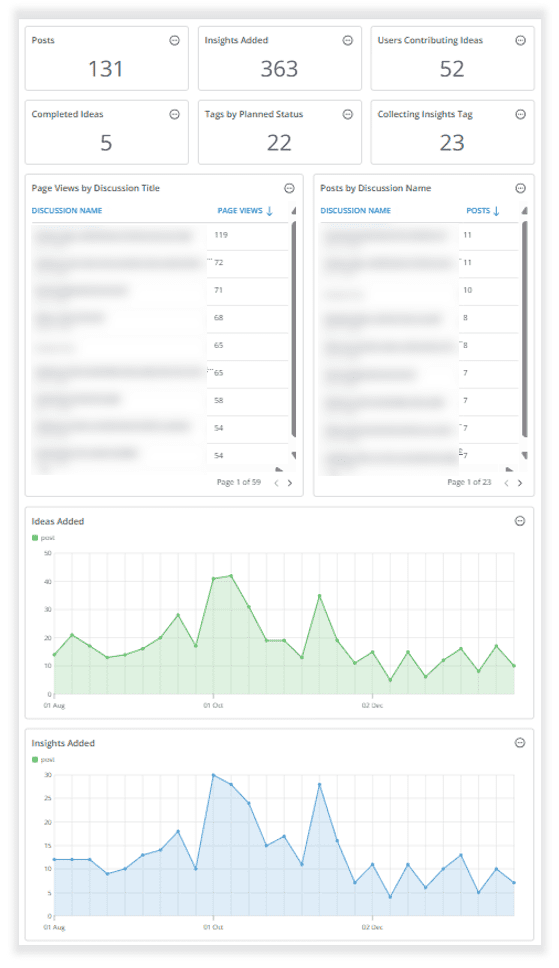
Bringing Ideation to Our Internal Team
The approach worked so well with our customers, we decided to replicate it internally for our own teams. We created a private ideation area inside Vanilla where employees can securely submit, discuss, and prioritize their own product ideas, giving our internal feedback process the same clarity and ease that our customers were already experiencing.
The best part about building ideation into Vanilla is that nothing about our setup is rigid. Everything—from how ideas are organized to what we call our status labels—is customizable. Which means if you’re thinking about using Vanilla to manage feedback in your own community, you can easily adapt everything we’ve done to fit your unique needs.
What Happens After a Product Idea Is Submitted
Here’s how our product ideation feedback moves internally:
1. Community Submission: Customers submit product ideas directly in our community’s ideation category.
2. Productboard Integration: Ideas automatically sync to Productboard—our team’s product management tool—so votes, comments, and edits become instantly available as organized notes. As you can see in the image below, each note includes the idea title, full description or comment, category details, and direct links to a user’s profiles and their activity.
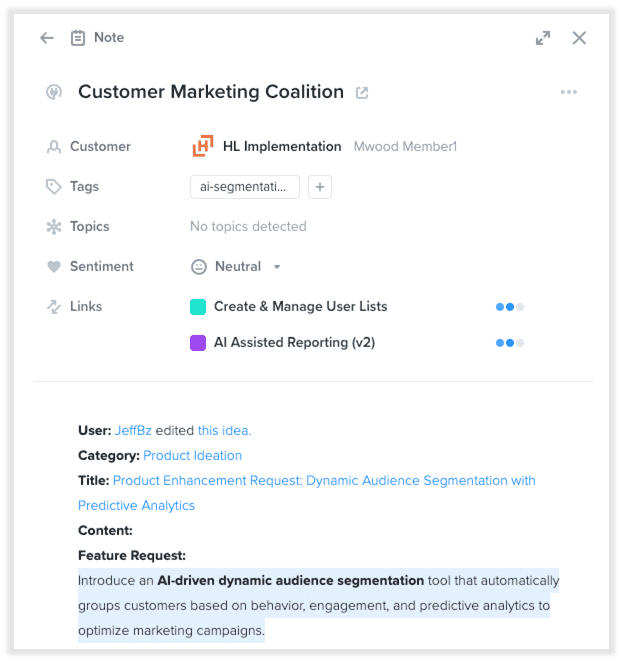
Our product managers review and prioritize this community feedback weekly, using Productboard to keep a real-time pulse on member insights without manual data transfer.
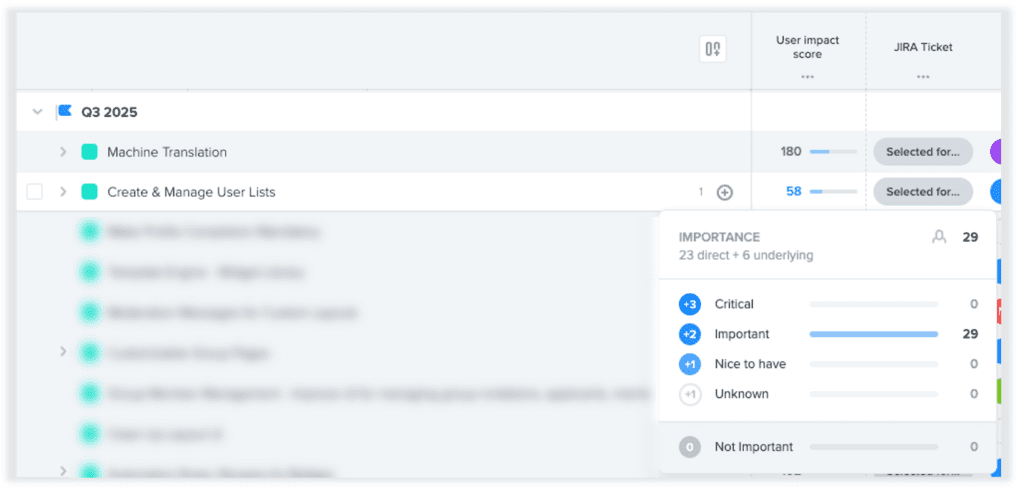
3. From Productboard to Jira: Once an idea is selected for development, product managers can push it directly into Jira for the engineering team. In the image above, this happens through the “Jira Ticket” column on the right.
Why We Made Our Product Roadmap Public
We also use Vanilla to publicly share our product roadmap directly within the community. It’s actually a Productboard Portal embedded into a Vanilla category using our Layout Editor and a Custom HTML widget. This way, customers can clearly see what’s currently in progress, what’s scheduled next, what’s available in beta, and what’s recently launched.

They can also click into each roadmap item to leave targeted feedback or rate how important a particular feature or improvement is to them.
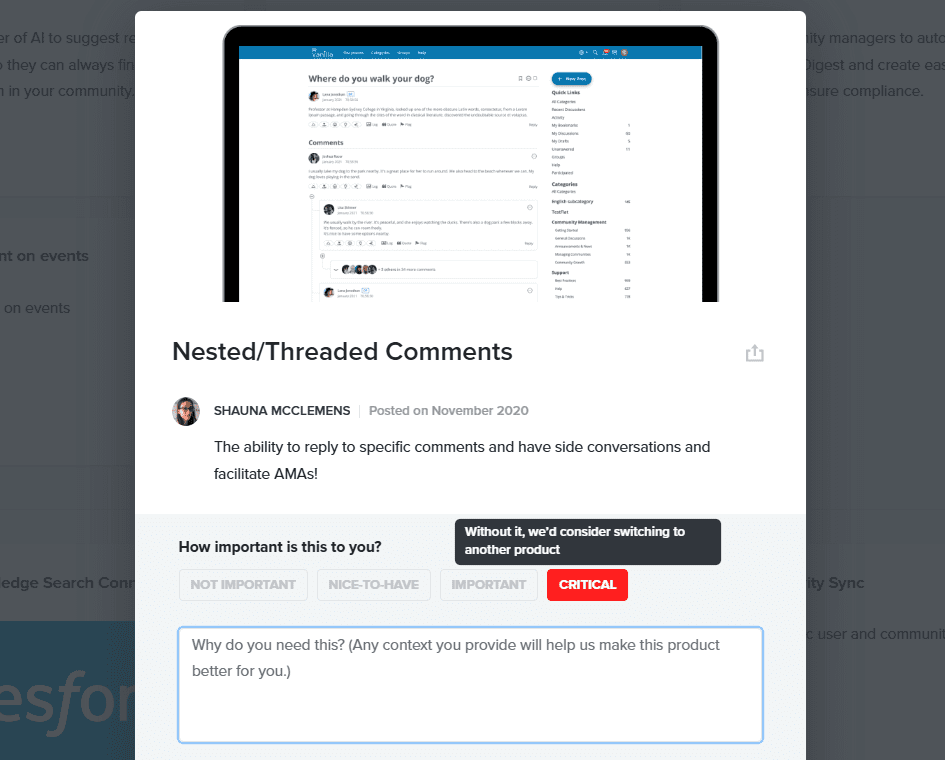
We release updates about every 2–3 weeks (around 20 times per year). With such a fast release cycle, we’ve found that maintaining a public roadmap is incredibly valuable for both our customers and our internal teams.
For one, customers appreciate the transparency. When they can see what we’re working on, and what’s coming soon, it builds trust and helps them plan ahead. It also saves them (and us) from having to track down updates across emails or support threads. Everything lives in one place, easy to check anytime.
A public roadmap also creates pressure, but a healthy kind. It compels our internal teams to clearly define priorities and timelines, reducing internal ambiguity and increasing alignment across product, sales, marketing, and customer success teams.
And because that visibility cuts down on confusion, we end up fielding fewer repetitive questions about features or fixes that are already in motion.
How Our Advocate Program Strengthens Product Development
We also enhance our ideation process with our Advocate Program. It started with a hand-picked group of active community members and has gradually expanded to include others who express interest, after connecting with our community manager to learn more. Advocates beta test features and discuss ideas directly with our product team. Here’s how it works:
- Each month, we select either a feature for beta testing or host product leadership discussions.
- Advocates get exclusive, early access to new features to stress-test and provide candid feedback.
- All activities take place in a private Advocate group, set up as a gated category in Vanilla and accessible only to members assigned the special “Advocate” role. Discussions, event announcements, and feature previews live here, creating a focused feedback environment.
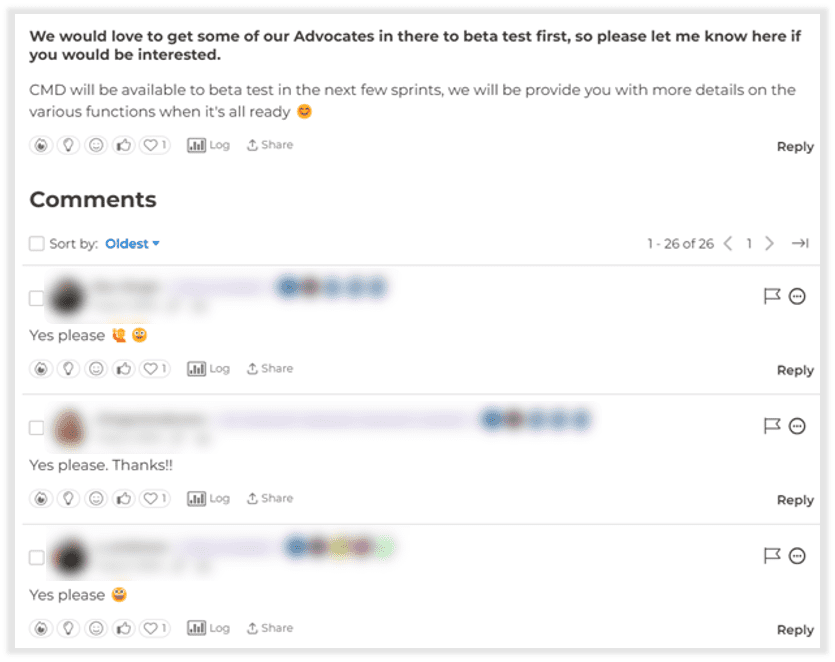
Beta testing through advocates means a slightly longer development cycle, but fewer post-launch surprises. Our customers gain direct access to our team, influencing our roadmap and helping shape products that genuinely solve their needs.
What We’ve Learned From Listening to Our Customers
Since fully embracing Vanilla’s ideation features, we’ve implemented over 120 customer-submitted ideas, including high-impact improvements like email digests and advanced analytics. Engagement has stayed consistently high, with thousands of upvotes, comments, and views. It’s clear our community genuinely values being involved in shaping the product.
But honestly, the biggest win has been trust. When customers see their ideas turn into actual product updates, they know we’re listening, and that builds real credibility. More than 90% of the customers whose ideas we’ve implemented are still with us. It’s not the only reason they’ve stayed, but it’s a meaningful signal that being heard makes a difference.